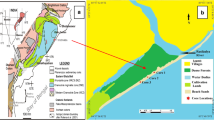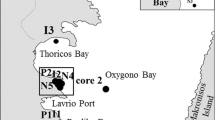Abstract
This article presents the results of radioecological studies on the territory of the Kostomuksha iron ore deposit (the Republic of Karelia, the Russian Federation, 64°38′55.0″N 30°44′58.1″E). Solution of the geoecological issues caused by the environmental pollution during the development, extraction, and enrichment of iron ore in large quantities has been shown by the example of the Kostomuksha Mining Enterprise, one of the largest in northwest Russia. The task solution was based on radioisotope methods. It has been determined that the concentration of naturally occurring radioactive isotopes is within the abundance percentage across the entire Kostomuksha Deposit. We found that some ore types have an increased potassium concentration. In the process of ore enrichment, radiopotassium migrates to the tailings dam of the Lake of Kostomuksha, resulting in pollution of the Kenti–Kento lake system with potassium-enriched sediments.








Similar content being viewed by others
References
AMPLITUDE (2016) Method for measuring the activity of radionuclides using a scintillation gamma spectrometer with the “Progress” software. Scientific and Technical Center “AMPLITUDE”, Moscow
Atlasov PP (1993) Aerospace monitoring of geological environment in the mining and processing industries of Karelia (1990–1993). Aerogeology, Moscow
Avdonin VV, Boytsov VE, Grigoriev VM (1998) Deposits of metallic minerals. Geoinformmark, Moscow
Bronder L, Solokhina A, Verevkina E, Nikiforov V (2014) Report of the Bellona Association “Industrial pollution of territories of Russian part of the Barents region”. EOC Bellona, St. Petersburg
Chalov PI (1991) Methodological guide to uranium-isotopic modeling of groundwater dynamics in conditions of active water exchange. Ilim, Bishkek
Fedorets NG (2001) Soil local monitoring in zone of action of the Kostomuksha Mining Enterprise. Proc KRC RAS 2:75–181
Fedorets NG, Solodovnikov AN (2013) Influence of emissions of the Kostomuksha Mining Enterprise on forest litter of pine forests in the North taiga subarea of Karelia. Proc KRC RAS 6:143–152
Fedorets NG, Bakhmet ON, Medvedeva MV (2015) Heavy metals in soils of Karelia. KRC RAS, Petrozavodsk
Gorkin AP (2006) Kostomuksha iron ore deposit. Geography. Rosmen, Moscow
Gorkovets VY, Rayevskaya MB (1997) Geology of the Kostomuksha Nature Reserve. Finland Environment Institute, Helsinki
Gorkovets VY, Sharov NV (2015) Kostomuksha ore region (geology, deep structure and mineralogy). KSC RAS, Petrozavodsk
Gorkovets VY, Maksimovish LA, Rayevskaya MB (2011) Kostomuksha—is the largest complex ore province of the Republic of Karelia. KSC RAS, Petrozavodsk
Grzymko TJ, Marcantonio BA, McKee CM (2007) Temporal variability of uranium concentrations and 234U/238U activity ratios in the Mississippi River and its tributaries. Chem Geol 243:344–356
Kiselev GP (1999) Even isotopes of uranium in geosphere. UB RAS, Ekaterinburg
Kiselev GP, Druzhinin SV, Bazhenov AV, Zykova EN, Kiseleva IM (2015) Radiological research in the Kostomukshsky Nature Reserve. Proc Kostomukshsky State Nat Reserve 1:172–182
Kolomytsev VA, Shiltsova GV (1998) Integrated environmental monitoring in Karelia (concept, program, methods, results 1992–1996). Forest Institute, Petrozavodsk
Konstantinov AK, Mashkovtsev GA, Miguta AK (2010) Uranium of Russian interior. VIMS, Moscow
Krasilnikov PV (1995) Soil map of Karelia of medium scale: concept and methods. Ecol Geogr Soils Karelia 2:102–106
Krutov VI (1997) Influence of gas-dust emissions the JSC “Karelsky Okatysh” on phytosanitary condition of pine forests. Probl For Phytopathol Mycol 1:41–43
Lazareva NP, Kuchko AA, Kravchenko AB (1992) Influence of aerotechnogenic pollution on the state of pine forests of northern Karelia. KSC RAS, Petrozavodsk
Litinsky PY (1996) Assessment of forest degradation in the impact zone of Kostomuksha Mining Enterprise emissions by remote methods. KSC RAS, Petrozavodsk
Luo S, Ku T, Roback R (2000) In-situ radionuclide transport and preferential groundwater flows at INEEL (Idaho): decay-series disequilibrium studies. Geochim Cosmochim Acta 64(5):867–881
Maher K, DePaolo JC, Christensen JN (2006) U-Sr isotopic speedometer: fluid flow and chemical weathering rates in aquifers. Geochim Cosmochim Acta 70:4417–4435
Malov AI, Kiselev GP (2008) Uranium in underground waters of the Mezen syneclise. UB RAS, Ekaterinburg
Ministry of Nature Management and Ecology of the Karelia Republic (2015) State report on the environment of the Karelia Republic in 2014. Verso, Petrozavodsk
Novikov SG (2015) Heavy metals in the soils of Karelia. KSC RAS, Petrozavodsk
Novikov SG (2016) The content of heavy metals in soils of Kostomuksha city. Mod Probl Sci Educ 5:1–8
Opekunova MG, Senkin OV (2001) Ecological monitoring of the Kostomukshsky Reserve and adjacent territories. SPBU, St. Petersburg
Osmond JK, Rydell HS, Kaufman MI (1968) Uranium disequilibrium in groundwater: an isotope dilution approach in hydrologic investigations. Science 162:997–999
Panteleeva YG (2006a) Assessment of environment state of Kostomuksha region of Karelia Republic on the basis of ecological and geochemical research. Notes Min Inst 1:26–28
Panteleeva YG (2006b) Environmentally hazardous elements and minerals in raw materials, products and wastes of JSC Karelsky Okatysh and levels of accumulation of pollutants in environment. Geol Miner Geoecol North-West Russia 1:236–238
Panteleeva YG (2007) Geochemical research of the influence of the iron-ore mining company “Karelsky Okatysh” on environment. Freib Forsch 516:68–72
Panteleeva YG (2009a) Ecological and geochemical monitoring in the zone of action of the iron ore enterprise «Karelsky Okatysh». SPBU, St. Petersburg
Panteleeva YG (2009b) Geochemical changes in environment in zone of influence of the JSC Karelsky Okatysh mining complex (Kostomuksha, Karelia Republic). PhD Thesis, St. Petersburg Mining University, St. Petersburg
Perelman AI (1989) Geochemistry. High School, Moscow
Potakhin SB (2007) Atlas of Karelian ASSR. PETRSU, Petrozavodsk
Riotte J, Chabaux F (1999) 234U/238U activity ratios in freshwaters as tracers of hydrological processes: the Strengbach Watershed (Vosges, France). Geochim Cosmochim Acta 63(9):1263–1275
Roback RC, Johnson TM, McLing TL (2001) Uranium isotopic evidence for groundwater chemical evolution and flow patterns in the Eastern Snake River plain aquifer, Idaho. Geol Soc Am Bull 9:1133–1141
RSI (2016) RS-700 Mobile Radiation Monitoring System. Radiation Solutions Inc., Ontario, Canada
SanPiN 2.6.1.2523-09 (2009) Norms of radiation safety NRB-99/2009. Moscow
Sapozhnikov YA, Aliev RA, Kalmykov SN (2006) Radioactivity of environment. Theory and practice, BINOM, Moscow
Sharov NV (2014) Opening and exploration of the Kostomuksha iron ore deposit. PETRSU Publishing house, Petrozavodsk
Smyslov AA (1974) Uranium and thorium in the Earth’s crust. Nedra, Liningrad
Smyslov AA, Moiseenko UI, Chadovich TZ (1979) Thermal regime and radioactivity of the Earth. Nedra, Liningrad
Tikhonov AI (2009) Nonequilibrium uranium in conditions of active water exchange and its use in geology and hydrogeology. Naumov Publishing House, Cheboksary
VIMS (2013) Method for measuring the volumetric activity of uranium isotopes (238U, 234U, 235U) in samples of natural (fresh and mineralized), process and waste water using alpha-spectrometric method with radiochemical preparation. VIMS, Moscow
Yakovlev EY (2016) The use of isotope-radiogeochemical methods for diamond deposits prospecting in Arkhangelsk diamondiferous province. PhD Thesis, MGRI-RGGRU, Moscow
Acknowledgements
Funding was provided by Russian Academy of Sciences (Grant No. 0409-2014-0132).
Author information
Authors and Affiliations
Corresponding author
Rights and permissions
About this article
Cite this article
Kiselev, G.P., Yakovlev, E.Y., Druzhinin, S.V. et al. Radioactive investigation of the impact the Kostomuksha Mining Enterprise on the radioecological state of adjacent areas, the Republic of Karelia, the Russian Federation. Environ Earth Sci 77, 264 (2018). https://doi.org/10.1007/s12665-018-7432-4
Received:
Accepted:
Published:
DOI: https://doi.org/10.1007/s12665-018-7432-4




